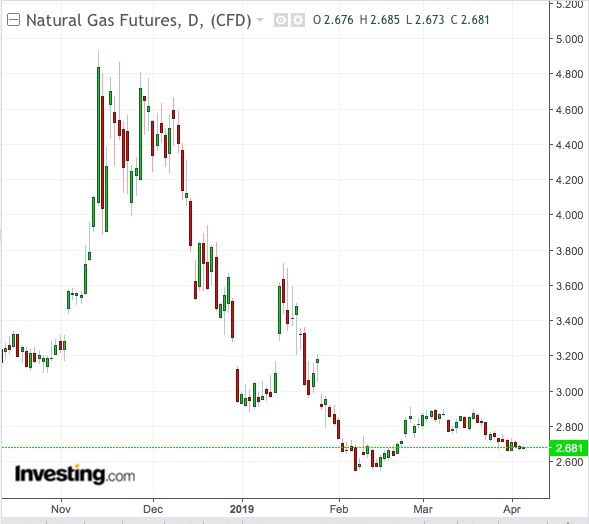The first gas injection into storage for this year may have just happened and the ensuing debate on spring pricing is likely to raise the market’s temperature—even if the weather doesn’t.
The U.S. Energy Information Administration is likely to say in its weekly report on natural gas due at 10:30 AM ET (14:30 GMT) that utilities injected 10 billion cubic feet into storage, after using the balance of the fuel produced last week to run heaters during one of the lesser cold weeks of the year. In the previous week to March 22, the EIA reported a withdrawal of 36 bcf from storage.
The EIA report comes after natural gas futures for May delivery on the New York Mercantile Exchange’s Henry Hub fell for a third-straight day, losing a total 1% this week, to settle at $2.677 per million British thermal units. Wednesday’s session bottom of $2.659 per mmBtu was just above last week’s two-month low of $2.656.
Gas Demand Weakens After One Of Heaviest Years Ever

The United States experienced one of its heaviest gas consumptions ever this winter as heating demand spiked from record low temperatures caused by a polar vortex. Gas prices reached more than 4-1/2-year highs of nearly $5 per mmBtu at the height of the cold weather in November.
With the advent of spring, however, the weather has gotten warmer, making pricing more challenging.
Investing.com’s daily technical outlook has a “Strong Sell” on natural gas, pegging Level 3 Fibonacci support at $2.642 for the May front-month gas contract on Henry Hub. Based
on where the contract settled Wednesday, that’s not much of a change, though the fundamental downside could be more once the selling starts in earnest.
Reuters reported on Wednesday that next-day natural gas prices at the Waha hub in West Texas plunged to record negative levels - meaning some drillers had to pay those with spare pipeline capacity to take the unwanted gas and got nothing for it.
Pipeline Constraints Trap Gas Supply From Reaching Customers
Pipeline constraints in the Permian basin in West Texas—the nation’s largest oil field, which also produces large volumes of gas—have squeezed gas prices there for some time. Weak demand and recent equipment problems on a key pipeline in New Mexico were exacerbating the problems, analysts said.
Dan Myers, analyst at Houston-based energy consultancy Gelber & Associates, also blamed the bearish state of affairs on expectations that there will be sizable injections into storage in the near term, with forecasts showing the weather will be neither cold enough for heaters to run or warm enough for cooling to kick in.
Last week, for instance, there were just 101 heating degree days, compared with 113 HDDs in the same week a year ago and a 30-year normal of 110 HDDs for this time of year, Reuters reported. HDDs measure the number of degrees a day's average temperature is below 65 Fahrenheit (18 Celsius), and are used to estimate demand to heat homes and businesses.
Milder Weather, Record High Production, Less LNG Exports
Aside from milder weather, record high production of dry gas and reduced flows of liquefied natural gas, or LNG, for export have also weighed on the market.
Analysts project that the current week could see an injection of up to 30 bcf, with the average estimate being a build of 15 bcf. That compares with last year’s decline of 20 bcf for the same week and the build of 5 bcf on average in the past five years.
Said Myers:
“Demand is weakening and will continue to fall into the weekend as a broad, warmer-than-normal pattern takes over.”
Cooler Forecasts In Later April Could Help Prices
But right after the next two weeks, he said forecasts showed cooler conditions. If those persist, they could limit storage injections, creating more typical inventories for this time of year that could aid price recovery.
Gas inventories have remained below the five-year average since September 2017, supporting prices above $2 levels. Current storage levels are about 18% percent below the same week a year ago and about 32% under the five-year average.
At an injection of 10 bcf last week, gas-in-storage would be at around 1.117 trillion cubic feet—still the lowest since 2014, EIA data showed.
